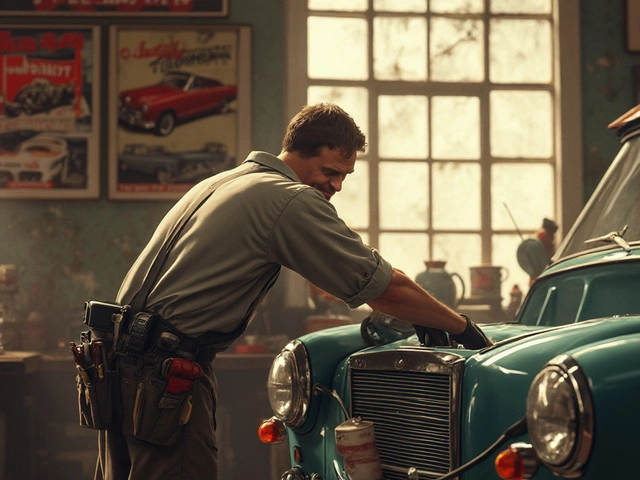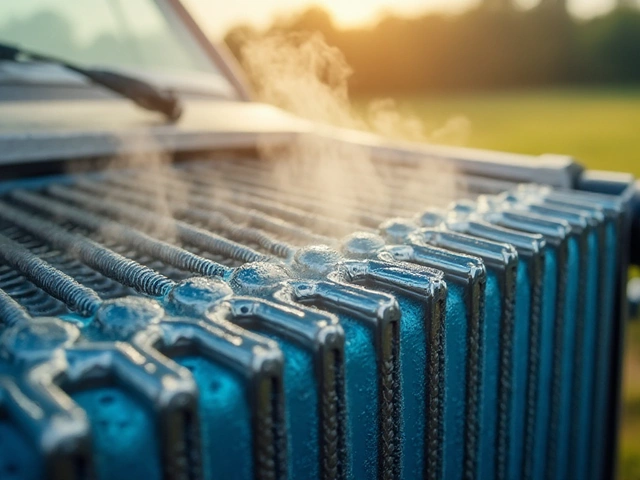Car radiators, often taken for granted, play a pivotal role in keeping vehicles humming along smoothly. Nestled under the hood, this unsung hero ensures that the engine temperature remains in a safe range, preventing overheating and potential breakdowns. But like all things mechanical, car radiators are not impervious to wear and tear.
Understanding why radiators go bad can be very beneficial, not just for car enthusiasts, but for anyone who spends time behind the wheel. Whether it’s corrosion sneaking in through the cooling system, or blockages hindering the flow of coolant, every driver should be aware of the tell-tale signs of a failing radiator. By learning the roots of these common issues, one can take proactive steps to extend the lifespan of their vehicle's cooling system. And with a bit of regular maintenance, those unexpected radiator headaches can be easily avoided.
- Introduction to Car Radiators
- Common Causes of Radiator Failure
- Signs of a Failing Radiator
- Preventive Measures and Maintenance
- When to Repair or Replace
- Conclusion and Final Thoughts
Introduction to Car Radiators
Every drive we take depends on a symphony of moving parts, each harmoniously working to ensure our journey is smooth and uninterrupted. At the center of this ensemble are the car radiators, vital components within a vehicle’s engine cooling system. Acting as the vehicle’s very own cooling tower, a radiator functions by dissipating the heat acquired from the engine, ensuring it stays within a temperature range that promotes efficiency and safety. Without the radiator's proficient cooling abilities, the engine would overheat, risking severe damage and costly repairs.
The inner working of this component revolves around a simple yet effective principle: heat exchange. As the engine operates, it generates a substantial amount of heat. This heat is absorbed by a coolant, typically a mix of water and antifreeze, and circulated through the engine's passageways. As the heated coolant makes its way to the radiator, it travels through thin tubes, accompanied by fins that dramatically increase the surface area. This design allows the ambient air, typically drawn in by a fan, to cool the fluid, aiding in dissipating the accumulated heat before it returns to restart its cycle in the engine.
In the world of automobiles, radiators are no strangers to evolution and innovation. Gone are the days when they were merely large, clunky metal units. Modern radiators, constructed from lightweight aluminum or high-end plastics, are designed to be both efficient and resilient. They are tailored to meet the needs of diverse vehicles, from compact cars to massive trucks. This innovation in radiator design has led to a substantial leap in performance while simultaneously reducing weight, a critical factor in today’s fuel-efficient car designs. To appreciate how important these components are, consider this insight from the experts:
"Without a functioning radiator, a vehicle is a ticking time bomb for overheating," shared John Smith, an automotive engineer at the forefront of engine design innovations.
The art of radiator design doesn't stop at materials and structure alone. Each radiator is calibrated to work in sync with the ever-complex electronic systems of modern vehicles, ensuring that even the tiniest fluctuations in temperature are swiftly corrected. The precise engineering involved demands an understanding of both fluid dynamics and thermodynamics, as every slight evolution in engine design necessitates a corresponding advance in radiator functionality.
Nowadays, maintaining optimal engine temperatures is crucial for embracing cleaner emissions and conserving fuel, aligning with global efforts to create eco-friendlier transportation options. The function and health of a car radiator directly impact this endeavor, as an efficient cooling system helps maintain engine performance, reducing the vehicle's overall carbon footprint. By understanding the role radiators play, car enthusiasts and everyday drivers alike can appreciate the innovation that goes into making our journeys not just possible, but also sustainable.
Common Causes of Radiator Failure
When it comes to vehicle health, the car radiators truly hold a position of paramount importance. These systems encounter a lot of stress as they work tirelessly to maintain the engine within optimal temperature limits. One of the most prevalent culprits behind radiator woes is corrosion. Over time, as coolant circulates through the cooling system, microscopic bits of metal can slowly erode away the protective barriers inside the radiator. This erosion gets worse with old or diluted coolant, leaving the radiator vulnerable to leaks. It’s like an unseen enemy slowly eating away at the metal heart, and this sneaky process often goes unnoticed until symptoms become evident under the hood.
Another frequently encountered cause of failure is contamination. The cooling system can become a breeding ground for rust, scale, or sediment if not properly maintained. These contaminants can inhibit the flow of coolant, obstructing its usual paths and leading to overheating. If the water pump, a critical companion to the radiator, fails to function correctly, flow issues are compounded. Addressing these blockages often involves thoroughly flushing the system to purge it of any debris, thus restoring unhindered coolant circulation. This constant vigilance might seem demanding, but it is essential for those wanting to avert untimely radiator demise.
Leaking is another villain in this narrative. Tiny fissures or punctures can emerge in the radiator, hoses, or the connected reservoir tank. These issues often originate from physical damage or the deterioration of connectors and seals due to age. For drivers, keeping a keen eye out for pooling fluids beneath the vehicle or the sweet, tangy aroma of leaking coolant can serve as invaluable early warning signals. Nobel-quality car radiators are designed to withstand significant pressure, yet even the slightest breach can lead to reduced cooling efficacy, putting the entire engine at risk. Regularly checking these connections can prevent minor leaks from escalating into major disasters.
Interestingly, poor craftsmanship or substandard materials can play a role as well. Not all radiators are created equal, and opting for cheaper versions might mean dealing with faulty architecture that simply can't handle the rigorous demands of a modern vehicle. Paul Smithson, an authority in automotive engineering, once noted,
"In the world of car radiators, the adage ‘you get what you pay for’ rings truer than ever. Skimping on quality can lead to higher costs down the road."With this in mind, choosing a radiator that meets or exceeds OEM standards is crucial for ensuring longevity.
Dealing with Temperature Variations
Temperature fluctuations add another layer of risk. Just think about the massive swings from a brisk winter morning to a sun-baked afternoon. These extreme shifts can cause repeated expansion and contraction. The resulting stress affects not just the radiator, but the entire cooling system. Such conditions demand that your radiator and its accompanying parts operate in seamless harmony, adapting to whatever the environment throws at them. Without routine inspections and maintenance, these thermal changes can dish out severe damage, turning a simple malfunction into a much more severe problem.
Signs of a Failing Radiator
Your car's radiator may not wave a red flag when it's in trouble, but if you pay close attention, it does whisper some tell-tale signs. The most evident indicator is the temperature gauge. When this needle climbs higher than normal, it’s a warning that the engine is overheating. This situation arises when the cooling system fails to regulate the heat produced by the engine, possibly pointing toward a malfunctioning radiator.
Another clue lies in unexpected puddles around your vehicle. If you suddenly notice coolant pooling beneath your car, it’s likely due to a radiator leak. This liquid may appear green, orange, or pink, depending on the type of antifreeze in your system. Such leaks not only diminish coolant levels but can also reduce the radiator’s efficiency in dissipating heat.
Pay attention to any strange sounds, especially a hissing noise coming from beneath the hood. This could indicate a pressure issue within the cooling system, potentially related to radiator performance. Such noises often accompany steam rising from the engine, which is never a sight you want to ignore. It’s a dramatic sign that the radiator or a connected hose might have ruptured.
Were you aware that even the smell your car emits can be a radiator warning sign? If you catch a sweet, syrupy scent while driving or after parking, you might be dealing with a coolant leak. Glycol, a component in antifreeze, smells sweet and is often a precursor to identifying radiator troubles.
"An overheating engine needs attention as soon as possible," says Chris Fix, a renowned automotive expert. "Ignoring these indicators can lead to costly repairs down the line."
And don't forget visual checks. A radiator on its way out might show signs of rust or discoloration. Corrosion can affect the metal components, leading to weak spots that might ultimately fail. Examine the radiator closely for any signs of wear or damage, especially around seams and fittings where leaks are common.
Finally, a failing radiator might also lead to a drop in heater performance. When your vehicle heater suddenly stops blowing hot air, it could be due to a lack of coolant circulation. Often, air entering the cooling system can cause this disruption, leading back to potential radiator issues. Keeping your eyes peeled for these signs can save both time and money in the long run as it allows for prompt action before more serious engine damage occurs.

Preventive Measures and Maintenance
Tackling the root causes of radiator issues is the first step in ensuring your car radiators serve their purpose diligently. Regular maintenance not only saves money in the long run but also ensures your vehicle's cooling system remains efficient. One prominent aspect of radiator upkeep involves routine inspections. Visual checks can reveal tell-tale signs of wear and tear. Look for corrosion at the seams and check for pooling coolant under the vehicle after it's been parked for a while. These are often early indicators of potential problems that could escalate if left untreated.
In addition to inspections, another essential practice is flushing the radiator. This process involves draining the old coolant and cleaning out the radiator before refilling it. By doing so, you remove sediment and debris that can accumulate over time, hindering the flow of the precious liquid. Experts typically recommend flushing the radiator at least once every two years, though some suggest doing it annually if you live in areas with extreme temperature fluctuations.
Monitoring coolant levels should become a habitual practice for any car owner. A low coolant level can lead to the engine overheating and causing serious damage. Checking the coolant level is simple: once the engine has cooled down, remove the radiator cap and ensure the coolant is up to the recommended level. Additionally, it's critical to use the correct type of coolant for your vehicle's make and model, as the wrong kind can lead to further issues.
A seasoned mechanic once said, "The best way to keep your radiator in peak condition is to use the right kind of coolant and change it regularly. Prevention is better than a costly repair."
Preventive Steps in Action
Here's where the rubber meets the road. Following a systematic approach can keep radiator troubles at bay. Installing a new thermostat with each coolant change can be beneficial as thermostats can wear out and lead to regulation issues. Also, consider investing in a high-quality radiator cap. It might seem trivial, but this inexpensive component plays a big role in maintaining pressure and preventing overheating.
Moreover, the hoses connected to radiator problems often get overlooked. Over time, hoses become brittle and may crack or leak. Regularly inspecting these hoses for any signs of wear, such as splits or bulges, ensures that the coolant circulates effectively. And when the time comes to replace them, choosing a high-quality alternative can make all the difference.
When Statistics Speak
According to data from the National Highway Traffic Safety Administration, overheating is among the leading causes of vehicle breakdowns on roadways, often linked to poor radiator maintenance. For enthusiasts who take pride in vehicle care, maintaining the cooling system is akin to a ritual. Informed choices, regular checks, and proactive maintenance culminate in a harmonious engine-cooling symbiosis, allowing for a smoother, worry-free driving experience.
By understanding and implementing these maintenance practices, drivers can enhance the lifespan of their car's cooling system, letting them enjoy the ride without the looming dread of unexpected radiator failures. After all, investing a bit of time and effort today can save you from roadside woes in the future.
When to Repair or Replace
Car radiators are essential components in the cooling system of any vehicle. Over time, they can suffer from wear and tear, leading to various problems that need addressing. The decision of whether to repair or replace a car radiator involves assessing the extent of the damage, costs involved, and the age of the radiator. If you've noticed your vehicle is overheating frequently, it's crucial to examine the radiator's condition. Small leaks or minor corrosion might be repairable, allowing you to extend the radiator's life without spending excessively on a full replacement. However, repairs should be considered only if the damage is superficial and the integrity of the radiator remains uncompromised.
When dealing with more severe issues like substantial leaks, significant blockages, or widespread corrosion, replacement becomes inevitable. Radiators exposed to external elements or neglected in terms of maintenance are more likely to face irreparable damage. Signs that indicate replacement include consistent overheating despite repairs, rust appearing on the exterior, and the coolant being discolored or containing visible debris. If a radiator has passed the average lifespan of around eight to ten years, it's time to think about a new one. As an expert once said, "Investing in a new radiator more than repays itself in preventing engine damage and ensuring reliability."
The cost considerations between repairing and replacing a radiator often sway decisions. A minor repair might be cost-effective in the short term, but repeated fixes can add up, potentially exceeding the cost of a new radiator. On the other hand, a brand new radiator, while initially more expensive, provides peace of mind with a warranty and restores the efficiency of your cooling system. Additionally, labor costs should be factored since installation can require significant mechanical expertise. Consulting a trusted mechanic or specialist who can assess the situation accurately and provide honest advice is always a recommended step.
Evaluating the Options
Each vehicle and situation will have its unique considerations. Repair is usually suitable for newer radiators with minor issues, while replacement is often necessary for older units with persistent problems. It’s not just about addressing immediate needs, but also weighing long-term benefits. By choosing a replacement when needed, you avoid the risks associated with car radiators that could fail unexpectedly. In summary, being proactive and making a choice based on accurate assessment will help maintain your vehicle's reliability and performance in the long run.Conclusion and Final Thoughts
The journey through understanding car radiators is a surprisingly enlightening one. These unassuming components, working diligently under the hood, may not be the most glamorous part of your vehicle, but their role is indisputable. They are the linchpin of your car’s cooling system, silently steering you away from overheating on a blistering summer day or from the frustration of unexpected engine trouble on a long drive. Recognizing why radiators can fail gives you a clearer picture of how to maintain your ride and keep it in peak condition.
There are many reasons a radiator might fail, from internal corrosion caused by neglected coolant to physical damage from debris on the road. Each issue can lead to more significant complications if left unattended. As with many aspects of vehicular maintenance, proactive care is the key. Frequent inspections, coolant flushes, and keeping an eye out for warning signs like unusual engine temperatures or fluid on the garage floor can make a world of difference. Consider the wisdom of car care expert John Haynes, who said in his renowned manual, "A well-maintained car is a safer car."
"Keeping up with regular maintenance not only prevents breakdowns but also extends the lifespan of your vehicle."These words still ring true today as a reminder of the value of diligence.
Incorporating these practices into your routine can vastly reduce the frequency of radiator-related issues. Should you encounter any trouble, knowing when to repair or replace your radiator is crucial. Often, minor leaks or blockages can be addressed with simple repairs, but severe corrosion or damage may necessitate a full replacement. A trusted mechanic can provide valuable guidance here, ensuring that you're making the most cost-effective and effective decision.
To wrap up, an ounce of prevention is truly worth a pound of cure when it comes to keeping your car's radiator in check. By understanding the potential pitfalls and actively tackling them, your journeys can remain smooth and uninterrupted. As you cultivate this knowledge, your comfort and confidence behind the wheel are likely to soar. After all, safeguarding such an integral part of our vehicle ensures that every ride, whether near or far, can be enjoyed without the nagging worry of an overheated engine.


